Small Ornamental Trees for Flower Beds (Pictures): Identification Guide
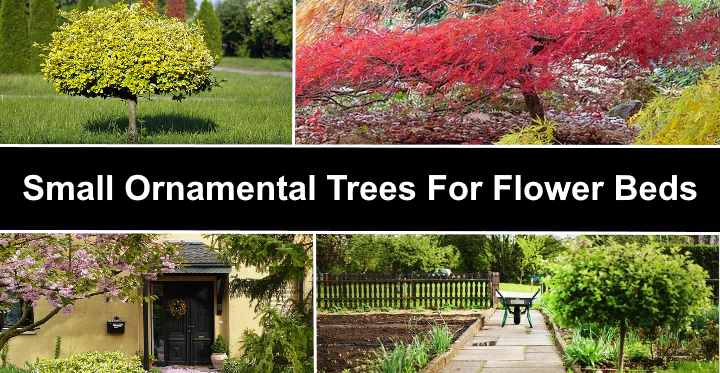
Small ornamental trees are crucial for landscaping, bringing color, vibrancy, and wildlife to your flower beds. Planting small and dwarf flowering or weeping trees means that they don’t crowd other flowers or shrubs. In addition, a small ornamental tree won’t block out light, potentially impacting other decorative plants in your yard.
There are plenty of compact species of trees under 10 feet tall that won’t outgrow a small yard or garden. For example, weeping Japanese maple trees, flowering crabapple trees, or dwarf evergreen conifers stay small and manageable. Growing a small ornamental tree in the right location can make an excellent focal point in your front or backyard and be beautiful throughout the year.
Even if you don’t have a flower bed to plant a small ornamental tree, many dwarf cultivars grow well in pots. So, you could still have a small flowering tree in a container garden, patio, balcony, or deck area.
This article is a guide to choosing the best ornamental trees that don’t grow more than 10 ft. (3 m) tall. These small flowering deciduous and evergreen trees can be an attractive addition to a flower bed or container garden.
How to Select Small Trees for Flower Beds
When selecting an ornamental tree, it’s crucial to consider your garden’s hardiness zone, sun exposure, type of soil, and surrounding plants. Also, it’s good to think about the plant’s mature size to ensure it complements the landscape and its visual appearance. Then, it would be best if you thought about how much maintenance the decorative tree requires.
Small Ornamental Trees for Flower Beds (With Pictures)
Small ornamental weeping trees, with their graceful branches and attractive foliage, are ideal for adding beauty to your garden landscape. You can plant them to create a focal point in the flower bed or add additional height.
‘Red Dragon’ Weeping Japanese Maple Tree (Acer palmatum dissectum ‘Red Dragon’)
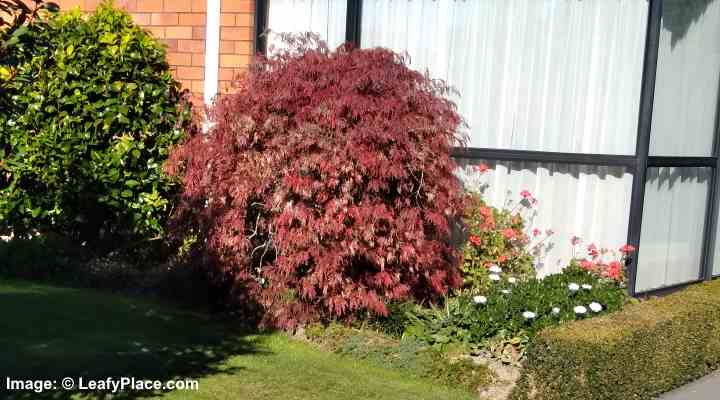
The small ornamental ‘Red Dragon’ Japanese maple tree has beautiful weeping red-purple foliage
The dwarf weeping Japanese maple ‘Red Dragon’ is a beautiful ornamental tree that remains under 10 feet tall, making it an ideal choice for flower beds. It features an elegant cascading structure adorned with leaves that range in color from burgundy to vibrant red and crimson. The rich, feathery maple leaves are pointed and can grow up to 5 inches (12 cm) in length. This small ornamental weeping Japanese maple tree typically reaches a height of 6 to 8 feet (1.8 – 2.4 m).
The deciduous weeping small maple tree performs best in partial shade to prevent color fading from the crimson red leaves. The ornamental weeping tree also has an umbrella-like canopy, spreading up to 5 ft. (1.5 m) tall. Suitable for USDA zones 5 through 8.
Mature Size: 6 and 8 ft. (1.8 – 2.4 m)
USDA Hardiness Zones: 5 to 8
Sun: Partial shade
Further reading: Dwarf Japanese maple trees.
Dwarf Weeping Mulberry (Morus alba ‘Chaparral’)
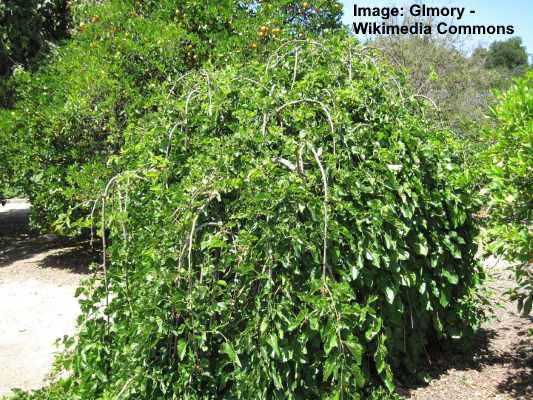
The small decorative weeping mulberry tree adds a focal point to front or backyards
The weeping mulberry is a broadleaf, deciduous tree with a weeping habit that remains under 10 feet tall. This small, cascading tree features dense foliage comprising shiny, dark green leaves. Following its flowering period, the tree yields abundant clusters of white, berry-like fruits. Ideal for growing as a small specimen tree, the weeping mulberry reaches 6 ft. (1.8 m) tall.
A weeping mulberry is easy to grow in USDA zones 4 through 8. The versatile ornamental weeping tree adapts to most soils and performs well in full sun to partial shade. Its deciduous foliage creates an attractive mound.
Mature Size: 6 ft. (1.8 m)
USDA Hardiness Zones: 4 to 8
Sun: Full sun to partial shade
Further reading: Types of mulberry trees.
Japanese Weeping Cherry (Prunus serrulata ‘Kiku-Shidare-Zakura’)
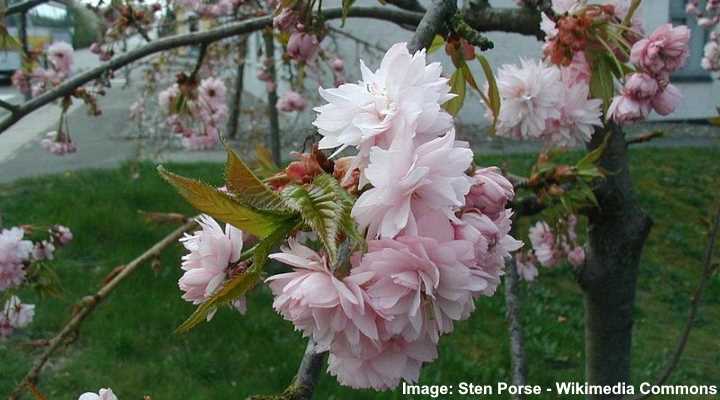
The Japanese dwarf weeping cherry tree has showy ruffled pink flowers
Often referred to as sakura, Japanese dwarf weeping cherry trees exhibit stunning pink, showy blossoms, making them an ideal choice for landscaping a front yard. The cherry leaves form a dense foliage on the umbrella-like tree canopy. During fall, these leaves transition to a golden yellow hue with hints of orange and bronze, offering year-long interest through their pendulous branches.
The bark of Japanese dwarf weeping cherry trees is shiny and smooth, featuring a copper color. This attribute provides the weeping dwarf cherry tree with captivating allure during the winter months when the droopy branches stand bare.
Japanese ornamental dwarf weeping cherry trees thrive in USDA zones 4 through 9 and require full sun. These cherry trees typically grow to a height of around 10 feet (3 m).
Mature Size: Around 10 ft. (3 m)
USDA Hardiness Zones: 4 to 9
Sun: Full sun
Further reading: Dwarf weeping cherry trees.
Small Flowering Trees Under 10 Feet Tall for Flower Beds (With Pictures)
Small flowering trees are a great way to add color and interest to flower beds in your garden. They produce beautiful, sweetly scented flowers when in bloom from spring until fall. Small or dwarf flowering trees have all the beauty of larger ones, just in a smaller package.
Sargent Crabapple (Malus sargentii)
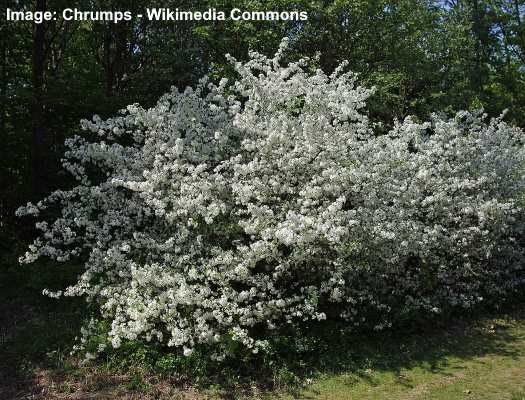
Sargent crabapple is an attractive flowering tree that is suitable for small spaces
The ‘Sargent’ crabapple is a small ornamental landscape tree that remains under 10 feet tall, making it an ideal choice for planting near flower beds. This beautiful tree features a spreading crown and zigzagging branches adorned with white flowers in spring and dense foliage in summer and fall. This slow-growing deciduous fruit tree produces clusters of small crabapples, similar in size to cherries.
The small flowering crabapple tree reaches a height of 6 to 10 feet (1.8 – 3 m) and a width of up to 12 feet (3.6 m).
Mature Size: 6 and 10 ft. (1.8 – 3 m) tall and up to 12 ft (3.6 m) wide
USDA Hardiness Zones: 4 to 8
Sun: Full sun
Lollipop Crabapple (Malus ‘Lollizam’)
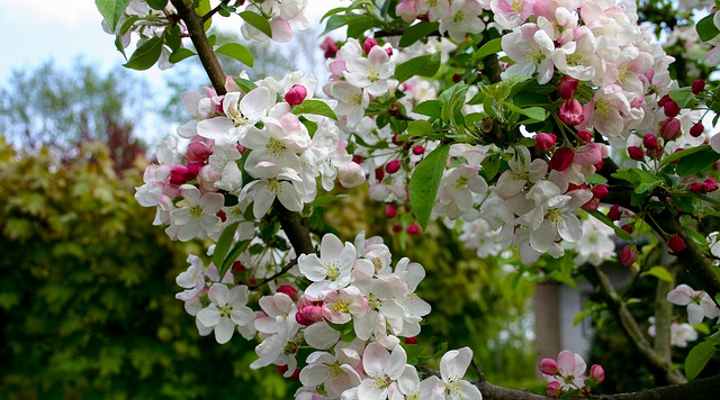
Lollipop crabapple is an ornamental dwarf tree suitable for the front yard
The ‘Lollipop’ crabapple is a magnificent landscaping tree known for its dense and compact growth habit. This tree becomes a vibrant centerpiece in your garden every spring, adorned with clusters of fragrant white flowers that captivate the senses.
Transitioning to autumn, the ‘Lollipop’ crabapple transforms once again, this time donning a rich shade of yellow. The changing foliage brings a new layer of beauty to your garden landscape.
The ‘Lollipop’ crabapple grows to a height of up to 8 feet (2.4 m) and spreads within a similar range. This characteristic makes it an excellent choice for enhancing flower beds, container gardens, and compact yards.
The ‘Lollipop’ crabapple is named as such due to its unique growth pattern that resembles a lollipop. The term “Lollipop” in the name refers to the tree’s distinctive shape, where its branches are upturned and rounded, similar to the shape of a lollipop on a stick. This growth habit sets the ‘Lollipop’ crabapple apart from traditional tree shapes, creating an eye-catching and playful visual effect.
Mature Size: Up to 8 ft. (2.4 m)
USDA Hardiness Zones: 4 to 8
Sun: Full sun
Further reading: Types of crabapple trees.
Star Magnolia Ornamental Flowering Tree (Magnolia stellata)
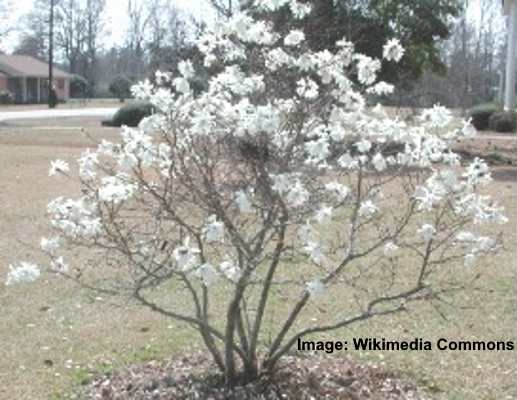
The small flowering star magnolia tree is a beautiful landscaping tree
The star magnolia is a small flowering tree, standing at less than 10 feet in height. During early spring, the tree boasts an abundance of brilliant white, star-shaped flower. These captivating, gently fragrant blooms boast up to 18 petals and measure 4 inches (10 cm) across. Following the graceful fading of the white blossoms, glossy green leaves emerge, maintaining their presence from summer through fall.
With its shrub-like growth, the star magnolia is an ideal ornamental tree for small yards or as a companion near flower beds. The star magnolia tree grows around 6.5 ft. (2 m) tall and wide. Plant the tree in full sun or light shade, sheltered from the wind.
Another dwarf magnolia that grows as a small flowering tree or shrub is the magnolia ‘Susan.’ This ornamental plant has stunning reddish-purple cup-shaped blossoms. It grows 10 ft. (3 m) tall and 6.5 ft. (2 m) wide.
Mature Size: Around 6.5 ft. (2 m) tall and wide
USDA Hardiness Zones: 5 to 9
Sun: Full sun or light shade
Related reading: How to care for magnolia trees.
Small Flowering Crape Myrtle Trees
Many varieties of crape myrtle trees are ideal for flower bed planting due to their compact size. In addition, the bushy, dwarf trees have deciduous or evergreen leaves, depending on the climate. When it blooms, the ornamental tree produces colorful flowering spikes consisting of papery flowers.
Here are some crape myrtle varieties suitable for compact landscaping requirements. Most cultivars grow outdoors throughout the year in USDA zones 7 to 10.
Mature Size: Up to 10 ft. (3 m)
USDA Hardiness Zones: 7 to 10
Sun: Full sun
Tonto Crape Myrtle (Lagerstroemia indica x fauriei ‘Tonto’)
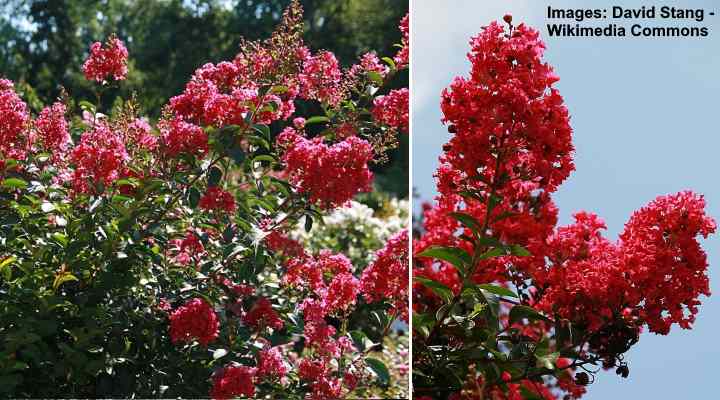
The small Tonto crape myrtle tree grows 10 ft. (3 m) tall and produces brilliantly colored pinkish-red blooms and purple-red foliage in the fall.
Its manageable height and spreading nature make the Tonto crape myrtle a versatile choice, fitting perfectly into various garden landscapes. It can be planted as a standalone specimen, near flower beds, or even in smaller yards.
Acoma Crape Myrtle (Lagerstroemia indica x fauriei ‘Acoma’)
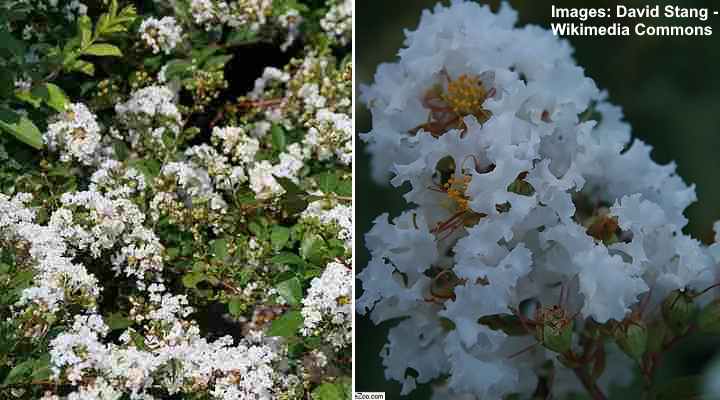
The Acoma crape myrtle is a delightful dwarf tree that boasts elegance and charm, making it an exceptional choice for home gardeners seeking beauty and versatility. Standing at a height of 10 feet (3 m), the Acoma crape myrtle offers a manageable size that suits various garden settings, including garden beds, and container arrangements.
The standout feature of the Acoma crape myrtle tree is its clusters of pure white showy flowers, characterized by their ruffled petals that exude an air of sophistication. These blooms infuse your garden with a serene and elegant ambiance.
Rhapsody in Pink Crape Myrtle (Lagerstroemia indica ‘Whit VIII’)
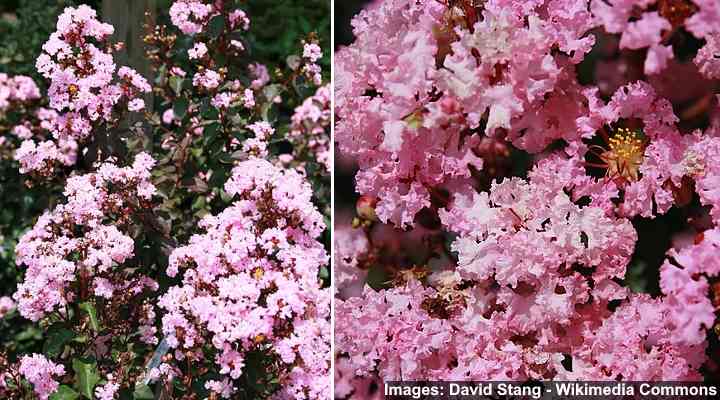
The deciduous ornamental tree has lush, dark green foliage and light-pink spring blossoms. The compact tree grows 6 to 10 ft. (1.8 – 3 m) tall.
Pink Velour Crape Myrtle (Lagerstroemia indica ‘Pink Velour’)
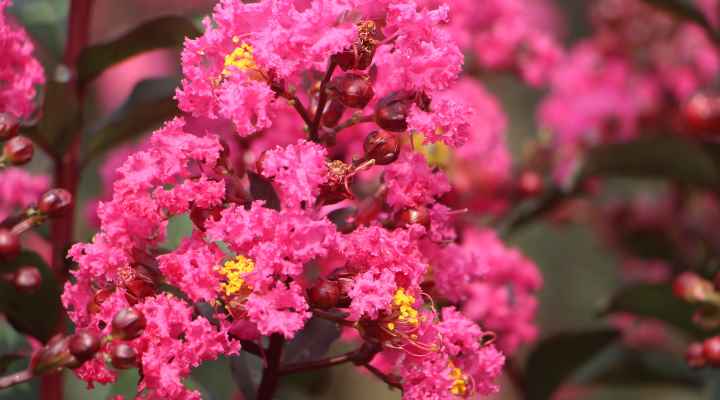
The shrub-like tree is a long-blooming cultivar that produces spectacular ruffled pink flowers from mid-summer until late fall. Ideal for USDA zones 6 through 9, the bushy tree grows around 6 ft. (1.8 m) tall.
Amelanchier ‘La Paloma’ (Dwarf Serviceberry)
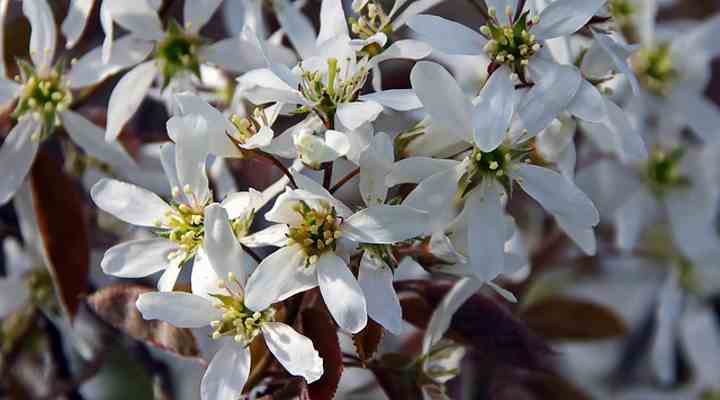
The white flowers of the dwarf serviceberry tree give decorative value to compact gardens
The serviceberry ‘La Paloma’ is an upright deciduous shrub or small tree with shiny bronze-red leaves that turn dark green and then brilliant shades of orange in the fall. The dwarf flowering tree is famous for its abundant fragrant white flowers that bloom in spring, followed by berries that ripen to red or purple-black in early summer.
The dwarf serviceberry tree grows around 8 ft. (2.4 m) high and thrives in full sun to partial shade. You can plant the tree as a specimen plant in moist, well-drained soil in USDA zones 4 through 8.
Mature Size: Around 8 ft. (2.4 m)
USDA Hardiness Zones: 4 to 8
Sun: Full sun to partial shade
Related reading: Serviceberry trees and shrubs.
Purple Leaf Sand Cherry (Prunus × cistena)
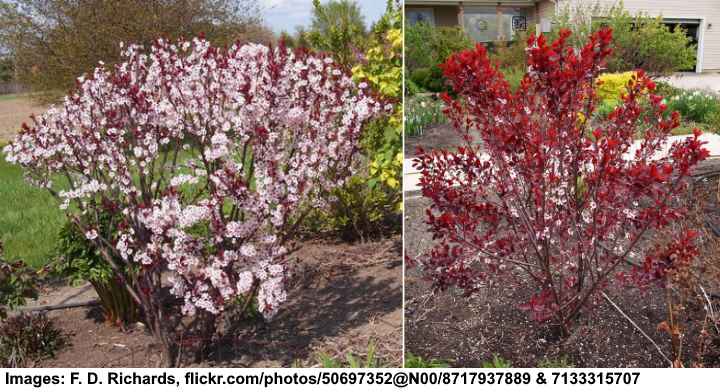
The small purple leaf sand cherry has stunning pink flowers and colorful foliage
The purple leaf sand cherry is a superb small ornamental tree to complement flower beds, container gardens, and compact yards. This gorgeous tree has maroon, purple, or red leaves that provide a stunning contrast with pinkish-white flowers throughout spring. The shrub-like tree grows around 6.5 ft. (2 m) tall.
The purple leaf sand cherry tree produces clusters of strong-tasting edible berries. The attractive tree is ideal as a specimen tree. Because of its shrubby growth, you can also grow the tree as an evergreen or deciduous hedge. In cooler climates, the lush foliage turns bronze.
Mature Size: Around 6.5 ft. (2 m)
USDA Hardiness Zones: 2 to 8
Sun: Full sun
Plumeria
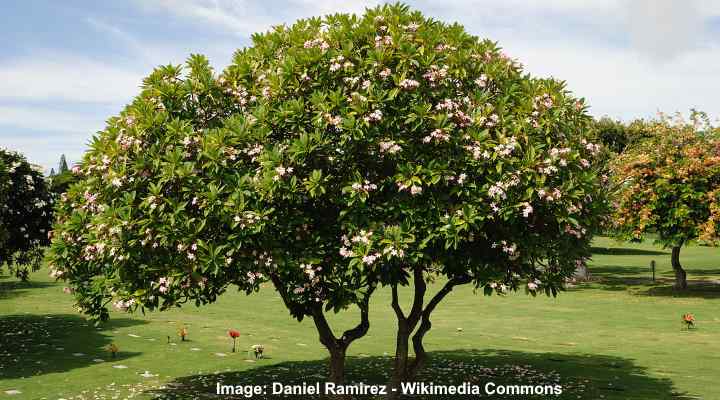
Plumeria (frangipani) tree
Also called the frangipani trees, plumeria is a group of exotic semi-evergreen dwarf trees for tropical or subtropical landscapes. These attractive trees have a rounded crown and grace your garden with fragrant, exotic, and showy pinwheel flowers in shades of red, white, pink, and yellow. Smaller plumeria varieties typically grow to a height of 6 to 8 feet (1.8 – 2.4 m), making them ideal for planting around your flower beds.
However, larger plumeria varieties can reach heights of 20 to 30 feet (6 to 9 meters) or even more under optimal conditions. Therefore, it’s important to select a variety that maintains a smaller size.
When selecting a plumeria variety for your flower beds, consider factors such as the growth habit, flower color, and fragrance that you prefer. The tree grows best in well-draining soil and full sun.
Plumeria trees are suitable for growing in USDA zones 9 through 12. These fast-growing trees are ideal for growing in Florida and other hot, humid regions. You can grow plumeria as a small potted tree in temperate regions and overwinter it indoors.
Mature Size: 6 to 8 ft. (1.8 – 2.4 m)
USDA Hardiness Zones: 9 to 12
Sun: Full sun
Related reading: How to care for plumeria trees.
Small Decorative Trees for Flower Beds (With Pictures)
Dwarf decorative trees growing in a garden landscape add year-round interest with colorful fall foliage, beautiful spring and summer blooms, and some height and visual appeal in a flower bed.
Hibiscus Tree

Single stemmed hibiscus trees (Hibiscus syriacus). The multi-stemmed shrubs can be trained to grow as trees with a single trunk
A hibiscus tree is a small ornamental plant characterized by large funnel-shaped tropical flowers. Their sizable tropical flowers bloom throughout summer in pink, red, lilac, purple and white hues. Hardy hibiscus shrubs can be trained to grow as trees. Or, in tropical regions, you can grow an evergreen braided hibiscus tree.
Hibiscus trees are ideal for flower beds because they grow up to 8 ft. (2.4 m) tall. However, you can also buy smaller dwarf hibiscus cultivars that only grow 4 to 5 ft. (1.2 – 1.5 m) tall.
The hibiscus tree is known for its easy growth and continuous blooming during the summer, as long as it gets plenty of sunshine.
Mature Size: Up to 8 ft. (2.4 m)
USDA Hardiness Zones: 5 to 8
Sun: Full sun
Related reading: Hibiscus Tree – Care and Growing Guide.
Eastern Redbud (Cercis canadensis)
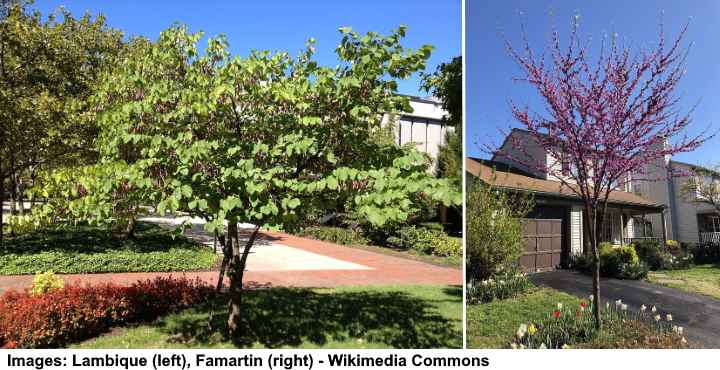
The Eastern redbud trees include several small cultivars for landscaping small gardens
The eastern redbud is a multi-stemmed ornamental tree, ideal for small to medium yards. Many redbud cultivars have beautiful, variegated foliage and showy floral displays of white or pink blooms. The attractive heart-shaped leaves can be green, with shades of pink or white around the margins.
Dwarf varieties of eastern redbud trees include the ‘Ace of Hearts’, with pea-like reddish-purple blossoms; the ‘Merlot’, with tiny bright pink flower clusters; and ‘Tennessee Pink’, with vibrant pink blooms on bare branches.
The shrub-like decorative trees grow between 9 and 12 ft. (2.7 – 3.6 m) tall and are suitable for USDA zones 5 through 9.
Mature Size: 9 and 12 ft. (2.7 – 3.6 m)
USDA Hardiness Zones: 5 to 9
Sun: Full sun to partial shade
Powderpuff Tree (Calliandra haematocephala)
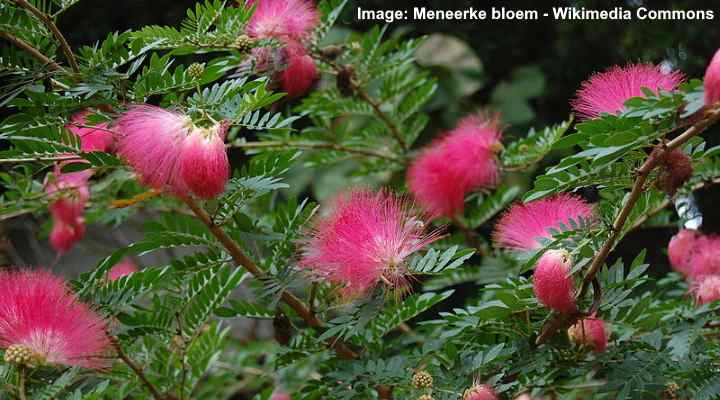
The small red powder puff tree has unusual-looking fuzzy flowers that come in shades of red or pink
The powderpuff tree is a fast-growing ornamental tree with shrubby growth. The spectacular feature of this ornamental dwarf tree is its feathery, powderpuff-like red flowers that look like soft spiky balls measuring 2” to 3” (5 – 7.5 cm). You can grow the flowering tree in flower beds in USDA zones 9 and above.
The powderpuff tree grows between 10 and 15 ft. (3 – 4.5 m). However, with some annual pruning, it’s easy to maintain its height around 8 ft. (2.4 m). The attractive spreading tree has glossy green leaves in a pinnately compound arrangement, contrasting with the fuzzy red or pink globose flowers.
Mature Size: 10 and 15 ft. (3 – 4.5 m)
USDA Hardiness Zones: 9 and above
Sun: Full sun
Pygmy Date Palm (Phoenix roebelenii)
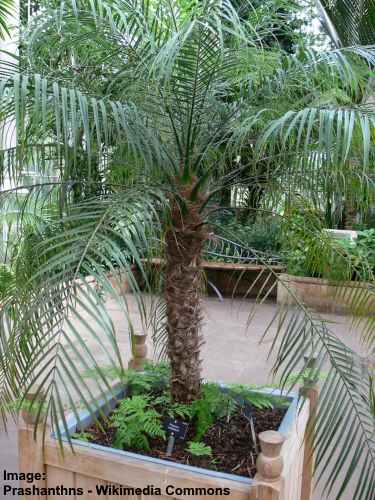
The pygmy date palm is a type of small palm tree with a spiky trunk
The pygmy date palm is a low-growing, single-stemmed small palm tree identified by its arching pinnate palm fronds, shaggy trunk, and clusters of small black fruits. The landscaping palm tree grows up to 10 ft. (3 m) tall and 8 ft. (2.4 m) wide. Due to its feathery, light foliage, the tree won’t create excessive shade underneath it.
The most attractive feature of the ornamental pygmy date palm is its arched fronds. Each palm leaf can measure up to 3 ft. (1 m) long and consists of several slender light green leaflets. The palm grows in gardens throughout Florida and is suitable for growing in the ground in zones 9 to 11.
Further reading: Small or dwarf palm trees.
Mature Size: Up to 10 ft. (3 m) tall and 8 ft. (2.4 m) wide
USDA Hardiness Zones: 9 to 11
Sun: Full sun to part shade
Shaina Small Japanese Maple (Acer palmatum ‘Shaina’)
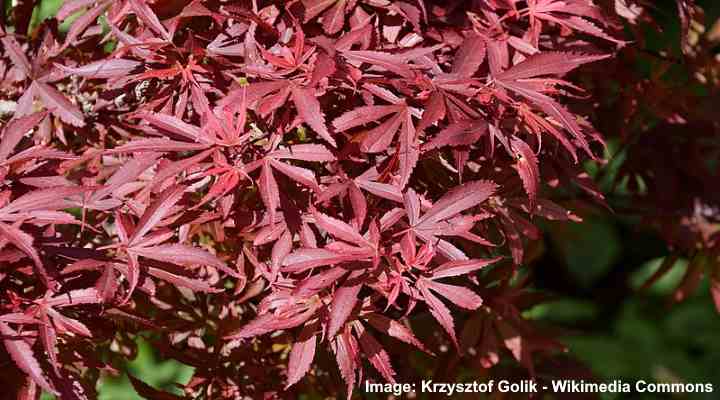
The small Shaina Japanese maple tree provides colorful foliage and grows in full sun to partial shade
The Shaina Japanese maple is identified by its eye-catching red, maroon, and crimson-red leaves. As a compact deciduous decorative tree, the Japanese maple has cascading branches and a bushy mounding growth habit. The maple tree has palmate red leaves and small reddish-purple flowers.
Suitable for USDA zones 5 through 9, the Japanese maple grows 4 to 5 ft. (1.2 – 1.5 m) tall in eight years. The small bushy tree thrives in full sun to partial shade in moist, well-drained soils. In winter, the tree’s bare branches provide an elegant silhouette.
Mature Size: 4 to 5 ft. (1.2 – 1.5 m)
USDA Hardiness Zones: 5 to 9
Sun: Full sun to partial shade
Small Evergreen Trees for Flower Beds and Small Yards (With Pictures)
Small evergreen trees add a year-round touch of color to your landscape. In addition, decorative evergreen trees are ideal anchor plants in landscapes, providing height, vertical accent, and visual interest during winter months when other plants appear bare.
Irish Yew ‘Fastigiata’ (Taxus baccata ‘Fastigiata’)
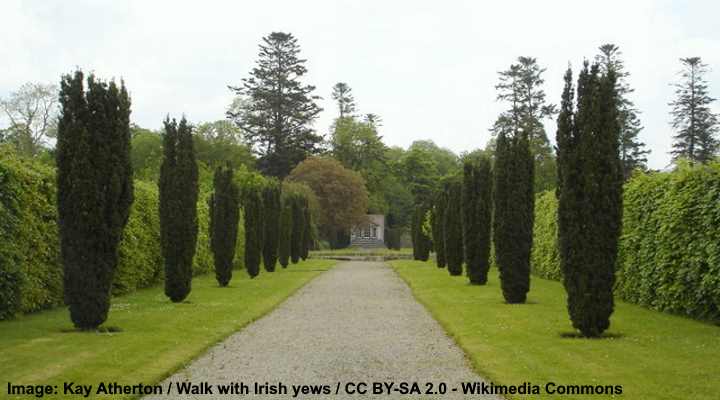
The dwarf columnar Irish yew doesn’t take up much space in small spaces or flower beds
The Irish yew tree is a dwarf evergreen conifer with upward growing branches, needle leaves, and small red berry-like fruits. The popular coniferous tree takes about 10 years to reach 4.5 to 10 ft. (1.4 – 3 m). However, due to its columnar growing habit, the pencil-like conifer won’t take up space in a flower bed.
The versatile Irish yew is cold-hardy in USDA zones 6 to 8 and thrives in full sun and shade. Apart from planting as a vertical accent in flower beds, the dense evergreen foliage makes the conifer tree ideal for a hedge, foundation planting, or privacy screen.
Mature Size: 4.5 to 10 ft. (1.4 – 3 m)
USDA Hardiness Zones: 6 to 8
Sun: Full sun and shade
Sky Pencil Holly (Ilex crenata ‘Sky Pencil’)
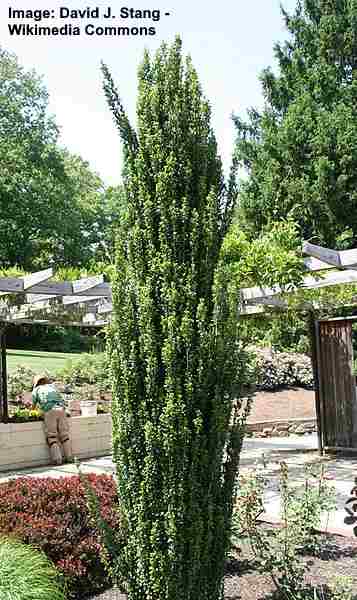
The ‘Sky Pencil’ holly has a narrow growth habit and is not too tall
The ‘Sky Pencil’ holly is a small, narrow evergreen ornamental tree for flower beds with a height that doesn’t grow more than 10 feet tall. The skinny ‘Sky Pencil’ holly is identified by its small, glossy green leaves, black berry-like drupes, and pencil-thin growing habit. The evergreen holly tree is ideal for compact, space-restricted beds because it grows 4 to 10 ft. (1.2 – 3 m) tall and wide.
The sky pencil holly tree thrives in USDA zones 5 through 8 in full to partial shade and moist, well-drained soil. This holly plant’s upright, columnar growth means it won’t take much room in a flower bed. It retains its narrow, columnar shape without the need for pruning.
Further reading: Holly Trees and Bushes.
Mature Size: 4 to 10 ft. (1.2 – 3 m) tall and wide
USDA Hardiness Zones: 5 to 8
Sun: Full to partial shade
Dwarf Pencil Point Juniper (Juniperus communis ‘Compressa’)
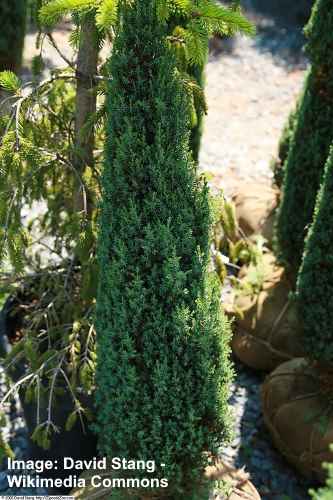
Dwarf pencil point juniper is a great tree for narrow spaces in your garden
The dwarf pencil point juniper is a type of narrow evergreen tree that grows to less than 5 feet tall.
Planting the dwarf pencil point juniper is a good choice for your yard, garden, or container if you need a tall, yet compact tree. The mature upright tree is only about 1 ft. (30 cm) wide and grows no more than 5 ft. (1.5 m) tall. Many gardeners love this miniature accent tree as it grows well in most types of soil. In addition, it’s a very hardy tree that withstands temperatures as low as -50°F (-45°C).
Further reading: Juniper Trees and Shrubs.
Mature Size: Up to 5 ft. (1.5 m)
USDA Hardiness Zones: 2 to 6
Sun: Full sun
Dwarf Hinoki Cypress Tree (Chamaecyparis obtusa)
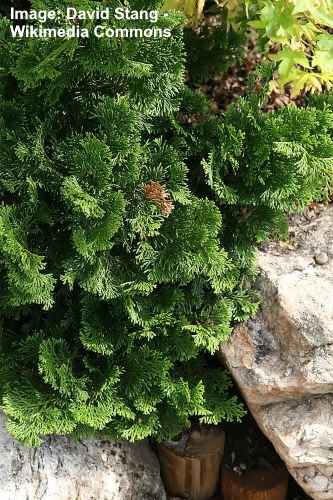
The dwarf hinoki cypress is a beautiful compact evergreen tree that makes an excellent addition to the landscape
Several dwarf Hinoki cypress trees are suitable for small flower beds where space is at a premium. The miniature evergreen tree is known for its soft feathery needles, dark green foliage, and globose brown cones. To add a vertical accent and all-year greenery to a small garden landscape, choose dwarf cypress trees that grow between 3 and 6 ft. (1 – 2 m).
Some of the most popular dwarf Hinoki cypress evergreen trees include ‘Kosteri,’ ‘Nana,’ ‘’Nana Gracilis,’ and ‘Spiralis.’
Mature Size: 3 to 6 ft. (1 – 2 m)
USDA Hardiness Zones: 4 to 8
Sun: Full sun
Small Ornamental Trees for Flower Beds (With Pictures)
Fernleaf Full Moon Maple Tree (Acer japonicum ‘Aconitifolium’)
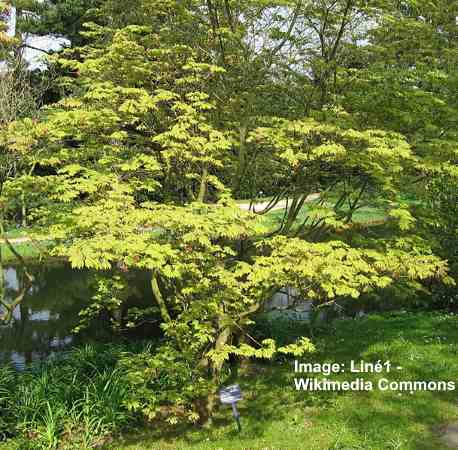
The dwarf ornamental fernleaf full moon maple is a compact deciduous tree with attractive feathery foliage and autumn color
Small Japanese maples are ideal for flower beds due to their small size and stunning bright red or scarlet foliage in the fall. These slow-growing dwarf trees have palmate, fern-like leaves, each with seven to 11 pointy lobes. They also have a compact, upright branching habit. In addition, they produce tiny red flowers and winged maple seeds known as ‘samaras’.
The Japanese maple ‘Aconitifolium’ reaches a height and width of 8 to 10 ft. (2.4 – 3 m), making it an ideal choice for small yards or compact spaces. This low-maintenance, versatile tree can be planted as an accent tree, a specimen plant, or even as an individual focal point. If you want to add some visual interest or a pop of color to your flower bed, consider planting this tree.
Mature Size: 8 to 10 ft. (2.4 – 3 m)
USDA Hardiness Zones: 5 to 7
Sun: Full sun to partial shade
Small Ornamental Chaste Tree (Vitex agnus-castus)
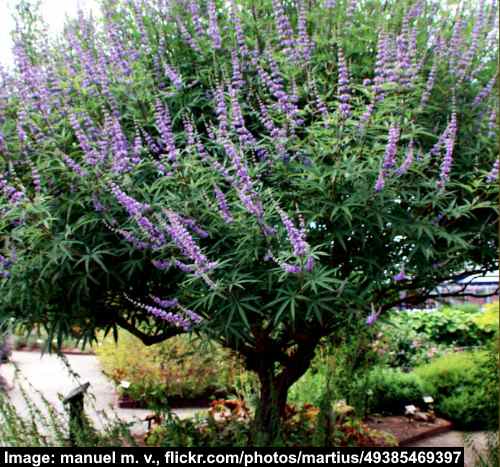
Chaste Tree (Vitex agnus-castus)
If you’re looking for an attractive tree for your flower bed, consider the chaste tree. This beautiful, summer-blooming tree is known for its clusters of sweet-smelling purple or blue-violet flower spikes. Also referred to as the monk’s pepper, this deciduous tree features opposite, palmately compound grayish-green leaves that have an aromatic scent. The flowers are multi-colored, coming in hues of either pink, white, or lavender. It also produces black, round fruits in autumn.
Shrub-like in nature, the chaste tree can be trained to grow as a tree. It usually reaches a height ranging from 8 to 10 ft. (1.8 – 3 m), making it perfect in size for flower beds. The tree is also tolerant of salt spray, and drought conditions. It is perfect for planting in cottage gardens, mixed borders, and xeriscapes. The attractive flower spires can also be used for cut flower arrangements and dried floral displays.
Mature Size: 8 to 10 ft. (1.8 – 3 m)
USDA Hardiness Zones: 7 to 9
Sun: Full sun
Japanese Flowering Quince (Chaenomeles Japonica)
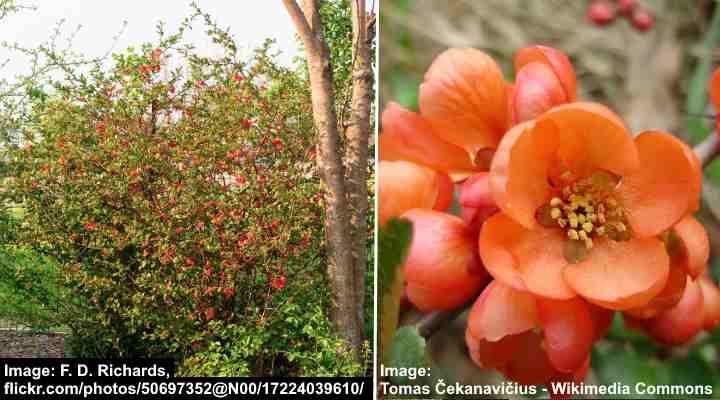
Growing the Japanese flowering quince in your flower bed will provide both color and beauty. This miniature deciduous tree is recognized for its stunning orange-scarlet, cup-shaped flowers with creamy yellow stamens. The tree’s charm is further enhanced by its shrub-like, rounded canopy shape. Once the flowering period ends, it produces round, yellow-green apple-like fruits. The leaves are alternate, leathery, and a shade of deep green.
For optimal growth, plant the Japanese flowering quince in moist, well-drained soil. This incredibly versatile tree can be planted as a low-flowering hedge, striking foundation plant, or specimen plant. It is drought-tolerant once established. Additionally, its thorn-covered branches make it a great option for creating an effective security screen around your backyard.
Mature Size: 2 to 3 ft. (0.6 – 1 m) tall and 3 to 6 ft. (1 – 1.8 m) wide
USDA Hardiness Zones: 5 to 9
Sun: Full sun to partial sun
Chinese Plum Tree (Prunus glandulosa)
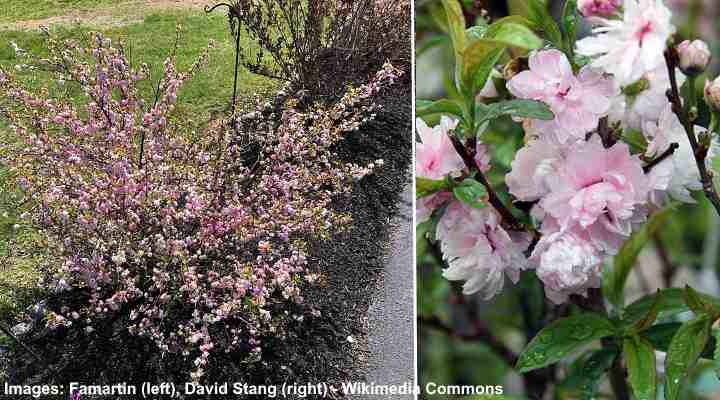
The Chinese plum tree is a compact ornamental tree with a shrub-like growth habit that makes a fantastic addition to a flower bed. The tree is known for its beautiful clusters of fragrant, pale-pink flowers that bloom in the spring. This eye-catching, pink-flowering tree showcases pointy, alternating, light-green leaves that turn into beautiful yellow-orange colors during the fall. It may also occasionally grow round, pinkish-red fruits.
Chinese plum trees grow best in fertile, moist, well-draining soil. Plant this ornamental tree as a decorative focal point, a wonderful accent plant, or an elegant specimen tree in your garden. With its beautiful pale-pink flowers and stunning fall colors, this tree’s presence is guaranteed to enhance the overall appearance of your landscape.
Mature Size: 4 to 5 ft. (1.2 – 1.5 m) tall and wide
USDA Hardiness Zones: 4 to 8
Sun: Full sun to partial shade
Yellow Oleander (Cascabela thevetia)
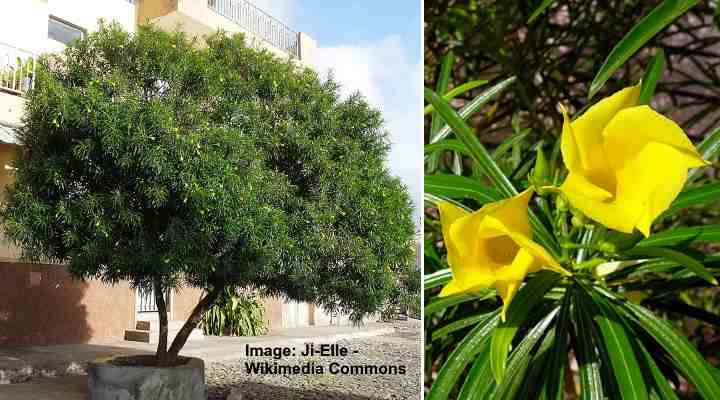
The yellow oleander is a beautiful evergreen tree with a compact, shrub-like growth habit, making it perfect for planting near a flower bed. It is recognized by its bright golden-yellow, trumpet-shaped flowers that are found in sparse clusters at the tips of its branches. Additionally, this decorative tree showcases elongated leaves with a glossy green appearance, creating a striking contrast with its vibrant yellow flowers. From late summer until autumn, the tree grows round, green seed pods that transition into a red-black color when ripe.
For optimal growth, plant the yellow oleander in moist, rich, well-drained soil. Although the tree is highly valued for its ornamental features, it’s important to note that all parts of the tree are toxic. Make sure to exercise caution when planting it in areas frequented by children or pets. Its luxuriant and glossy green leaves, along with its rounded canopy shape, make it a superb option for ornamental use, establishing a captivating centerpiece or accent plant.
Mature Size: Up to 8 ft. (2.4 m) tall and 4 ft. (1.2 m) wide
USDA Hardiness Zones: 8 to 10
Sun: Full sun to partial shade
Weeping Scotch Laburnum (Laburnum alpinum ‘Pendulum’)
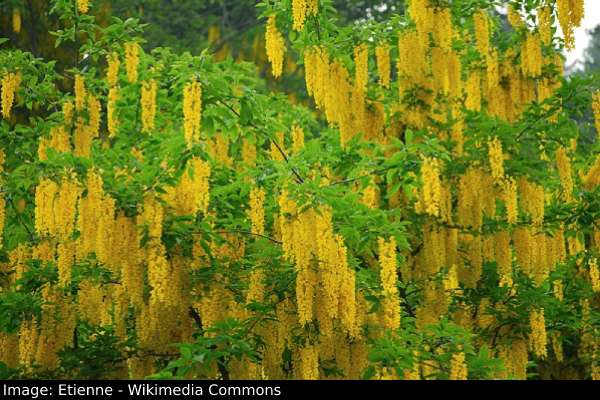
With its compact drooping habit and small size, the weeping scotch laburnum is a great choice for planting in a flower bed. This small, weeping tree is characterized by its fragrant, hanging yellow flower clusters. Its umbrella-shaped canopy and lush, glossy green leaves add to its charm. In autumn, the tree produces brown seed pods. If you want to enhance the appearance of your garden, consider planting this tree.
The weeping scotch laburnum grows in any well-drained soil. This versatile tree can serve as a standalone focal point or accent plant in your garden. Additionally, its cascading, weeping branches and small size allow it to be used to enhance the appearance of compact spaces. Plant this tree for its ornamental features, such as its scentful yellow flowers, umbrella-shaped canopy, and lush green foliage.
Mature Size: 6.5 to 8 ft. (2 – 2.5 m) tall and up to 6.5 ft. (2 m) wide
USDA Hardiness Zones: 5 to 7
Sun: Full sun or partial shade
Flame Azalea (Rhododendron calendulaceum)
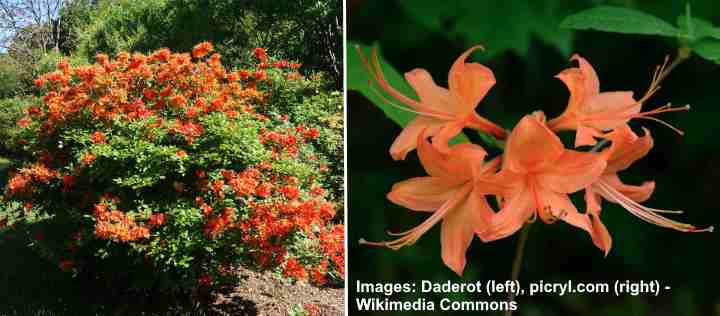
Flame azaleas can add a beautiful touch to flower beds with their bright orange-red, showy star-shaped flowers. The flowers have protruding, slightly curved stamens and buds that resemble candle flames, giving the tree its name. This ornamental, deciduous tree has a shrubby growth habit. It features elliptic to ovate leaves with a slightly hairy texture and a mid-green color. In autumn, the leaves transition into spectacular colors of red and yellow before dropping later in the season.
For optimal growth, plant the flame azalea in acidic, moist, well-draining soil. This versatile tree can make a charming flowering hedge, privacy screen, or individual focal point. Additionally, its fragrant flowers attract bees and hummingbirds, making the tree perfect for planting in wildlife gardens.
Mature Size: 4 to 8 ft. (1.2 – 2.4 m) tall and wide
USDA Hardiness Zones: 5 to 8
Sun: Partial shade or full sun
Waratah (Telopea speciosissima)
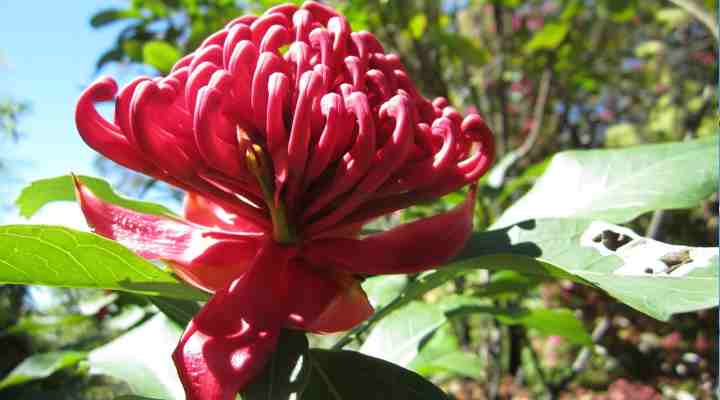
Suitable for adding an ornamental touch to a flower bed, the waratah is a beautiful tree with a shrub-like growth habit. The tree is characterized by its unique, vivid red flower heads that bloom during spring. Each flower head may be composed of 10 to 240 individual flowers. The flower head is surrounded by a circle of leaf-like bracts, ranging in color from red, maroon, to pink. The waratah also has dark green, glossy leaves with serrated edges.
The optimal soil type for the waratah is well-drained, sandy-loam soil. The tree’s unique flower heads, leafy bracts, and dense appearance make it an excellent choice as an individual focal point or for planting as a specimen tree or accent plant. Additionally, its flowers also make great cut flower arrangements or floral displays.
Mature Size: 3 to 10 ft. (1 – 3 m) tall and wide
USDA Hardiness Zones: 8 to 10
Sun: Full sun to partial shade
Red Flowering Grevillea Trees

Red flowering grevilleas are attractive evergreen trees renowned for their spider-shaped bright red flowers. Reaching only 4 to 8 ft. (1.2 – 2.4 m) tall, they are perfect for planting in flower beds or compact spaces. The flowers feature elongated, curved stamens with a strong scent, making them especially inviting to birds, bees, and hummingbirds.
Red flowering grevilleas grow best in full sun to partial shade in well-drained soil. They are highly versatile and can be used as excellent hedges, privacy screens, specimen plants, foundation plants, or individual focal points. Their nectar-rich flowers, which attract various pollinators, establish them as great choices for including in wildlife gardens.
Mature Size: 4 to 8 ft. (1.2 – 2.4 m) tall, depending on the species
USDA Hardiness Zones: 9 to 11
Sun: Full sun to partial shade
Common Lilac (Syringa vulgaris)
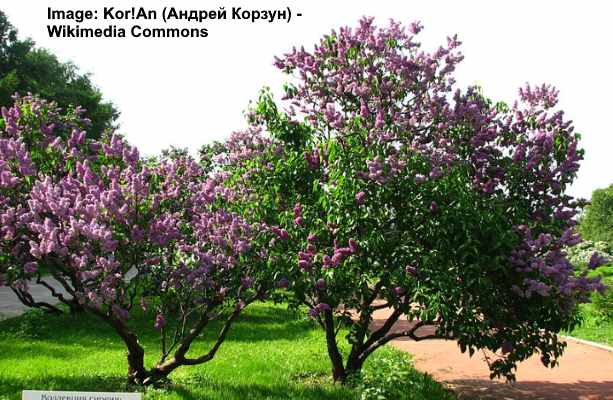
Lilac tree
The common lilac is ideal for planting in flower beds because of its shrub-like, compact growth habit and stunning cone-shaped clusters of highly scentful, pinkish-purple blooms. It is well-known for its rounded, bushy form and multi-colored flowers, ranging in shades of white, pink, lavender, or blue. The tree also features heart- or oval-shaped leaves that range in color from bluish-green to dark green, further enhancing its overall appearance.
To ensure the best growth, plant the common lilac in well-drained, fertile, moist soil. This highly-versatile tree can be grown as a standalone hedge or privacy screen due to its dense, lush foliage. Planting the common lilac in your flower bed is a fantastic decision, as they offer enduring spring blossoms and emit a captivating fragrance that attracts bees and butterflies.
Mature Size: 8 to 10 ft. (2.4 – 3 m) tall and 5 to 6 ft. (1.5 – 1.8 m) wide
USDA Hardiness Zones: 3 to 8
Sun: Full sun for best flowering
Angel’s Trumpet (Brugmansia suaveolens)
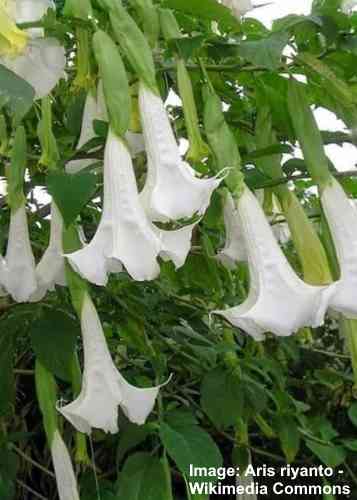
Known for its hanging, large, pure-white trumpet-shaped flowers, the angel’s trumpet is an excellent addition to any flower bed. The tree’s blooming period lasts from midsummer until autumn. Its leaves are alternate, oval-shaped, dark green, and covered with a thin layer of fine hairs. This small, white-flowering tree also has many branches that form a dense, vase-like canopy, adding to its decorative charm.
The angel’s trumpet grows in organically rich, fertile, well-drained soil. This distinctive semi-evergreen tree presents an excellent option for elevating garden beds and borders. It can serve as a captivating centerpiece, or add a tropical touch to patios and decks. Keep in mind that the plant can be harmful if consumed, so exercise caution when planting in areas where children or pets might be around.
Mature Size: 3 to 8 ft. (1 – 2.4 m) tall and 2 to 4 ft. (0.6 – 1 m) wide
USDA Hardiness Zones: 9 to 11
Sun: Full sun or partial shade
Flowering Maple ‘Victor Reiter’ (Abutilon ‘Victor Reiter’)
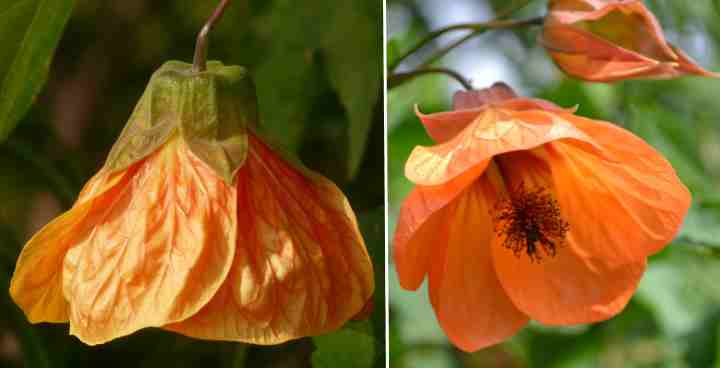
The ‘Victor Reiter’ flowering maple is a beautiful evergreen tree with a shrubby growth habit. Perfect for planting in flower beds, the tree is recognized for its charming peach-colored, bell-shaped flowers that hang gracefully from the branches. The flowers have distinctive, greenish-yellow centers, adding a delightful touch to their appearance. It also showcases glossy, maple-like, dark-green leaves that create a beautiful contrast against the bright orange flowers.
The ‘Victor Reiter’ flowering maple thrives in organically rich, moist soil that drains well. With their stunning orange blooms, flowering maples provide a superb decorative choice to introduce a splash of color to compact gardens, container plantings, or as a focal point in any outdoor setting.
Mature Size: 6 to 8 ft. (1.8 – 2.4 m) tall and 4 ft. (1.2 m) wide
USDA Hardiness Zones: 9 to 11
Sun: Full sun to partial shade
Related articles:
